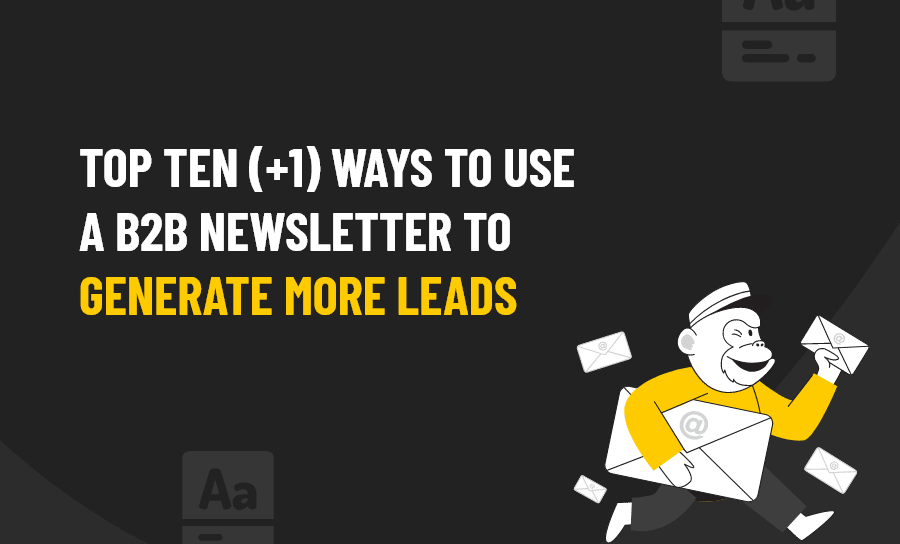Creating, and sending out a regular B2B newsletter can be a great way to passively generate leads, better connect with warm prospects and nurture existing clients and customers. It can also serve as proof of your industry expertise and as a brilliant brand builder as well as a content marketing tool. But only if it’s good.
WHY BOTHER WITH A BUSINESS NEWSLETTER?
In a very general sense, a B2B newsletter reports news and events related to an organization or company. This report is sent in an electronic or written form to members, clients, customers, or employees.
What’s the point of a newsletter for business?
The point is going to be different per company, but newsletters need to offer your readership value in general. In short, they have to be worth reading.
Just what you write will vary, according to the audience you are targeting and what you want from them, but the ultimate goal of providing value should always remain your number one consideration.
Ask yourself: Who is going to read the newsletter, and how can I deliver value to their inbox?
If you’re targeting customers, you might want to communicate how your new product or service features can help them. If you’re targeting prospects, it might make more sense to offer less product-focused content, and point them to interesting or useful resources instead, at least initially.
As we check newsletters for clients and prospects who tell us the tactic hasn’t been working for them, we find they are far too often overloaded with hard-sale messages, probably more than 75% of the time. A B2B newsletter that focuses heavily on sales won’t perform well because people don’t want to read sales – they want information. If that isn’t something your newsletter offers then you are less likely to perform well for B2B lead generation.
This usually means their target audience has learned to tune out the newsletter after few mailings and consign it to the trash. This is a costly error that, with some clear foresight and careful thought, can be avoided.
So how do you write a good business newsletter? That’s just what we are going to break down for you here, step by step.
1. OFFER NEWSWORTHY CONTENT
Providing your audience with content that is considered newsworthy or of interest to them is one way to almost guarantee the readership of your newsletter.
Example: If you are a financial planner, a newsworthy report could be details about luxury tax increases or decreases by the government, because it affects how your clients spend their cash, something you already know they really care about.
2. OFFER HOW TO PIECES
How-to articles do not need to be long, but they should include easy-to-follow directions that can be understood by your readers in a short time. These should also be well placed and have the ability to reach potential leads on social media or as a blog post because those are easy to share.
Example: An auto shop can send monthly newsletters which include a section on how to check the battery cables, or how to check the tire pressure on a car. Easy for them to write about, but very valuable for the newsletter’s audience.
3. TELL PRODUCT TALES
People love to read product or service stories. We’re not talking about sales pitches, but about real stories. Stories could involve how a product helped save time for a client or how your service helped save money for a customer. You can view these stories as a soft sell – and it’s a great lead generation idea. Tell them the right way and people can be convinced by the story and experience itself to use your service or product.
4. OFFER BACKGROUND INFORMATION
People are also curious about a product or company’s past, when the organization was founded or created, and anything that has affected a product’s growth.
Example: If you run a bakery, you can explain how your bakery came into being, when and why cupcakes or cakes were invented, or details about particular ingredients used in your items.
You can also showcase your employees. People like to see who they are/who they might be doing business with. Not just their professional credentials and achievements though.
Have an employee who’s been doing a lot of work for charity, or who has a particularly interesting hobby? Include it in a newsletter profile, people are naturally fascinated by that kind of thing and it helps demonstrate to warm leads and prospects that there are real humans behind your business, something that always helps build trust. If you have a website you can also post it there and increase the number of your blog subscribers.
5. SOLVE PROBLEMS FOR YOUR READERS
Generating leads is not just about sales. It is also about helping solve problems for your newsletter’s readers will cast you as a hero. If helping people is not part of your B2B lead generation strategy you are missing out on many a potential customer.
Example: A personal trainer can send out a newsletter explaining the benefits of plant-based eating to lose weight or ease health problems. Or how to keep up with an exercise regimen when you can’t get to the gym. These newsletters can be especially effective right now, as people are actively searching for this kind of information in their ‘new normal’ lives.
6. CREATE CHECKLISTS
People love checklists. Not only will they read them voraciously, but they’ll print them out and use them too. They will also often share really useful checklists with their colleagues. Including a good checklist in your newsletter – one that preferably includes a link to a printable PDF version – can be an excellent way to generate new leads and build your brand as well as keep your ‘regular’ readers interested in what you might share next.
7. CREATE PRODUCT GUIDES
While you don’t want to fill your business newsletter with lots of hard sales pitches, as we mentioned earlier, soft sell is just fine. One way to do this is to offer product guides covering just what some of your products/services are and have to offer.
And as usual, make sure your newsletters or guides are accessible online through a popular social media platform like Facebook, Twitter, or as blog content. Your audience will appreciate the diversity and your newsletter signup rate will increase.
8. MAKE USE OF THE POWER OF IMAGES
A B2B newsletter needs to be engaging to read, but the best of them also make great use of images. Just like images draw the eye on social media to a certain post in a sea of similar posts great images can encourage email recipients to keep reading, rather than just skimming your newsletter before filing it away (in the trash).
9. BE CONSISTENT
It’s not enough to send two or three B2B newsletters every year whenever you happen to get around to it. Set a consistent schedule – once a month is perfect – and then stick to it.
Doing so will get your audience used to receiving this useful content from you, and, if it really is helpful, actually looking forward to seeing it pop up in their inbox.
10. BE MINDFUL OF SENDING BEST PRACTICES
BONUS TIP: TIE YOUR B2B NEWSLETTER TO YOUR LARGER LEAD GENERATION CAMPAIGNS
To be effective as a lead generation and lead nurturing tool your B2B email newsletter should be tied to the rest of your lead generation efforts, rather than treated as a stand-alone tactic. Make sure it works within your content marketing strategy.
This is really very simple to do. If you maintain a blog on your website – which you really should – ensure that one of your recent posts is teased in an email newsletter. Make sure that the social icons in the footer of your email actually lead to your company’s social accounts – lots of people forget that one – so your readers can connect with you there.
You should also keep a close eye on the analytics behind your newsletter. Who is opening it? Who is actually reading it? Who is clicking on links or downloading the content you share (such as those handy checklists we mentioned earlier?)
Many email tools do offer very robust analytical tools that can tell you an awful lot about who your most engaged readers are and what it is about your email newsletter they find most interesting. You can then take this information and begin approaching these people individually as the warm prospects they really are and start using that sales pitch at last!






